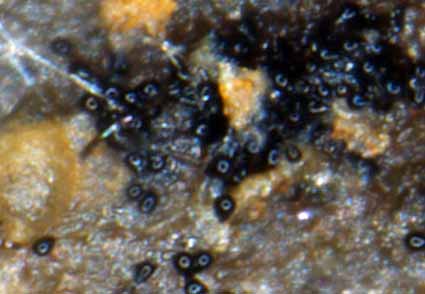Abstract
In this study, a novel lignicolous freshwater species, Parafuscosporella xishuangbannaensis, which was collected from Manfeilong reservoir in Xishuangbanna, Yunnan Province, China, is described and illustrated. The new species was established based on morphological characteristics and multi-locus phylogenetic analyses of combined LSU, SSU, ITS and rpb2 sequence data. Parafuscosporella xishuangbannaensis is characterized by reduced conidiophores, holoblastic, monoblastic, integrated, terminal, hyaline, cylindrical conidiogenous cells, and acrogenous, obovoid to subglobose, brown to dark brown conidia with a septum near the base and a paler, wedge-shaped basal cell. Parafuscosporella xishuangbannaensis differs from its phylogenetically close sister taxon P. pyriformis in lacking cylindrical or moniliform conidiophores.
References
<p align="justify"><span style="color: #000000;"><span style="font-family: Times New Roman, serif;"><span style="font-size: small;">Boonyuen, N., Chuaseeharonnachai, C., Nuankaew, S., Kwantong, P., Pornputtapong, N., Suwannarach, N., Jones, E. & Somrithipol, S. (2021) Novelties in Fuscosporellaceae (Fuscosporellales): Two new <em>Parafuscosporella</em> from Thailand revealed by morphology and phylogenetic analyses. <em>Diversity</em> 13 (11): 517. https://doi.org/10.3390/d13110517</span></span></span></p>
<p align="justify"><span style="color: #000000;"><span style="font-family: Times New Roman, serif;"><span style="font-size: small;">Boonmee, S., Wanasinghe, D.N., Calabon, M.S., Huanraluek, N., Chandrasiri, S.K.U., Jones, G.E.B., Rossi, W., Leonardi, M., Singh, S.K., Rana, S., Singh, P.N., Maurya ,D.K., Lagashetti, A.C., Choudhary, D., Dai, Y.C., Zhao, C.L., Mu, Y.H., Yuan, H.S., He, S.H., Phookamsak, R., Jiang, H.B., Martín, M.P., Dueñas, M., Telleria, M.T., Kałucka, I.L., Jagodziński, A.M., Liimatainen, K., Pereira, D.S., Phillips, A.J.L., Suwannarach, N., Kumla, J., Khuna, S., Lumyong, S., Potter, T.B., Shivas, R.G., Sparks, A.H., Vaghefi, N., Abdel-Wahab, M.A., Abdel-Aziz, F.A., Li ,G.J., Lin, W.F., Singh, U., Bhatt, R.P., Lee, H.B., Nguyen, T.T.T., Kirk, P.M., Dutta, A.K., Acharya, K., Sarma, V.V., Niranjan, M., Rajeshkumar, K.C., Ashtekar, N., Lad, S., Wijayawardene, N.N., Bhat, D.J., Xu, R.J., Wijesinghe, S.N., Shen, H.W., Luo, Z.L., Zhang, J.Y., Sysouphanthong, P., Thongklang, N., Bao, D.F., Aluthmuhandiram, J.V.S., Abdollahzadeh, J., Javadi, A., Dovana, F., Usman, M., Khalid, A.N., Dissanayake, A.J., Telagathoti, A., Probst, M., Peintner, U., Garrido-Benavent, I., Bóna, L., Merényi, Z., Boros, L., Zoltán, B., Stielow, J.B., Jiang, N., Tian, C.M., Shams, E., Dehghanizadeh, F., Pordel, A., Javan-Nikkhah, M., Denchev, T.T., Denchev, C.M., Kemler, M., Begerow, D., Deng, C.Y., Harrower, E., Bozorov, T., Kholmuradova, T., Gafforov, Y., Abdurazakov, A., Xu ,J.C., Mortimer, P.E., Ren, G.C., Jeewon, R., Maharachchikumbura, S.S.N., Phukhamsakda, C., Mapook, A. & Hyde, K.D. (2021) Fungal diversity notes 1387–1511: taxonomic and phylogenetic contributions on genera and species of fungal taxa. <em>Fungal Diversity </em>111: 1–335.</span></span></span></p>
<p align="justify"><span style="color: #000000;"><span style="font-family: Times New Roman, serif;"><span style="font-size: small;">Chomnunti, P., Hongsanan, S., Aguirre-Hudson, B., Tian, Q., Persoh, D., Dhami, M., Xu, J., Liu, X., Stadler, M. & Hyde, K.D. (2014) The sooty moulds. <em>Fungal Diversity</em> 66: 1–36. https://doi.org/10.1007/s13225-014-0278-5</span></span></span></p>
<p align="justify"><span style="color: #000000;"><span style="font-family: Times New Roman, serif;"><span style="font-size: small;">Jeewon, R. & Hyde, K.D. (2016) Establishing species boundaries and new taxa among fungi: recommendations to resolve taxonomic ambiguities. <em>Mycosphere</em> 7 (11): 1669–1677. https://doi.org/10.5943/mycosphere/7/11/4</span></span></span></p>
<p align="justify"><span style="color: #000000;"><span style="font-family: Times New Roman, serif;"><span style="font-size: small;">Jayasiri, S.C., Hyde, K.D., Ariyawansa, H.A., Bhat, D.J., Buyck, B., Cai, L., Dai, Y.C., Abd-Elsalam, K.A., Ertz, D. & Hidayat, I. (2015) The Faces of Fungi database: fungal names linked with morphology, phylogeny and human impacts. <em>Fungal Diversity</em> 74: 3–18. https://doi.org/10.1007/s13225-015-0351-8</span></span></span></p>
<p align="justify"><span style="color: #000000;"><span style="font-family: Times New Roman, serif;"><span style="font-size: small;">Katoh, K. & Standley, D.M. (2013) MAFFT multiple sequence alignment software version 7: improvements in performance and usability. <em>Molecular Biology and Evolution</em> 30: 772–780. https://doi.org/10.1093/molbev/mst010</span></span></span></p>
<p align="justify"><span style="color: #000000;"><span style="font-family: Times New Roman, serif;"><span style="font-size: small;">Liu, Y.J., Whelen, S. & Hall, B.D. (1999) Phylogenetic relationships among ascomycetes: evidence from an RNA polymerse II subunit. <em>Molecular biology and evolution</em> 16 (12): 1799–1808. https://doi.org/10.1093/oxfordjournals.molbev.a026092</span></span></span></p>
<p align="justify"><span style="color: #000000;"><span style="font-family: Times New Roman, serif;"><span style="font-size: small;">Miller, M.A., Pfeiffer, W. & Schwartz, T. (2010) Creating the CIPRES Science Gateway for inference of large phylogenetic trees. <em>In: Gateway Computing Environments Workshop</em> <em>2010</em> (GCE), New Orleans, Louisiana, November 2010, pp. 1–8. https://doi.org/10.1109/GCE.2010.5676129</span></span></span></p>
<p align="justify"><span style="color: #000000;"><span style="font-family: Times New Roman, serif;"><span style="font-size: small;">Miller, M.A., Schwartz, T., Pickett, B.E., He, S., Klem, E.B., Scheuermann, R.H., Passarotti, M., Kaufman, S. & O’Leary, M.A. (2015) A Restful API for access to phylogenetic tools via the CIPRES science gateway. <em>Evolutionary Bioinformatics</em> 11: 43–48. https://doi.org/10.4137/EBO.S21501</span></span></span></p>
<p align="justify"><span style="color: #000000;"><span style="font-family: Times New Roman, serif;"><span style="font-size: small;">Nylander, J.A. (2004) <em>MrModeltest</em> 2.2. Department of Systematic Zoology, Uppsala University, Uppsala, Sweden.</span></span></span></p>
<p align="justify"><span style="color: #000000;"><span style="font-family: Times New Roman, serif;"><span style="font-size: small;">Page, R.D. (1996) TreeView: an application to display phylogenetic trees on personal computers. <em>Computer Applications in the Biosciences</em> 12: 357–358. https://doi.org/10.1093/bioinformatics/12.4.357</span></span></span></p>
<p align="justify"><span style="color: #000000;"><span style="font-family: Times New Roman, serif;"><span style="font-size: small;">Phookamsak, R., Norphanphoun, C., Tanaka, K., Dai, D.Q., Luo, Z.L., Liu, J.K., Su, H.Y., Bhat, D.J., Bahkali, A., Mortimer, P., Xu, J. & Hyde, K.D. (2015) Towards a natural classification of Astrosphaeriella-like species; introducing Astrosphaeriellaceae and Pseudoastrosphaeriellaceae fam. nov. and <em>Astrosphaeriellopsis</em>, gen. nov.<em> Fungal Diversity </em>74: 143–197. https://doi.org/10.1007/s13225-015-0352-7</span></span></span></p>
<p align="justify"><span style="color: #000000;"><span style="font-family: Times New Roman, serif;"><span style="font-size: small;">Rehner, S.A. & Buckley, E. (2005) A <em>Beauveria </em>phylogeny inferred from nuclear ITS and EF1-α sequences: evidence for cryptic diversification and links to <em>Cordyceps</em> teleomorphs. <em>Mycologia</em> 97: 84–98. https://doi.org/10.1080/15572536.2006.11832842</span></span></span></p>
<p align="justify"><span style="color: #000000;"><span style="font-family: Times New Roman, serif;"><span style="font-size: small;">Su, H.Y., Udayanga, D., Luo, Z.L., Manamgoda, D.S., Zhao, Y.C., Yang, J., Liu, X.Y., Mckenzie, E.H.C., Zhou, D.Q. & Hyde, K.D. (2015) Hyphomycetes from aquatic habitats in Southern China: species of <em>Curvularia</em> (Pleosporaceae) and <em>Phragmocephala</em> (Melannomataceae). <em>Phytotaxa</em> 226: 201–216. https://dx.doi.org/10.11646/phytotaxa.226.3.1</span></span></span></p>
<p align="justify"><span style="color: #000000;"><span style="font-family: Times New Roman, serif;"><span style="font-size: small;">Vilgalys, R. & Hester, M. (1990) Rapid genetic identification and mapping of enzymatically amplified ribosomal DNA from several <em>Cryptococcus</em> species. <em>Journal of Bacteriology</em> 172: 4238–4246. https://doi.org/10.1128/jb.172.8.4238-4246.1990</span></span></span></p>
<p align="justify"><span style="color: #000000;"><span style="font-family: Times New Roman, serif;"><span style="font-size: small;">Yang, J., Maharachchikumbura, S.S.N., Bhat, D.J., Hyde, K.D., Mckenzie, E.H.C., Jones, E.B.G., Alsadi, A.M. & Lumyong, S. (2016) Fuscosporellales, a new order of aquatic and terrestrial Hypocreomycetidae (Sordariomycetes). <em>Cryptogamie Mycologie</em> 4: 449–475. https://doi.org/10.7872/crym/v37.iss4.2016.449</span></span></span></p>
<p align="justify"><span style="color: #000000;"><span style="font-family: Times New Roman, serif;"><span style="font-size: small;">Yang, H., Dong, W., Yu, X.D., Bhat, D.J., Boonmee, S. & Zhang, H. (2020) Four freshwater dematiaceous hyphomycetes in Sordariomycetes with two new species of <em>Parafuscosporella</em>. <em>Phytotaxa</em> 441: 19–34. https://doi.org/10.11646/phytotaxa.441.1.2</span></span></span></p>


